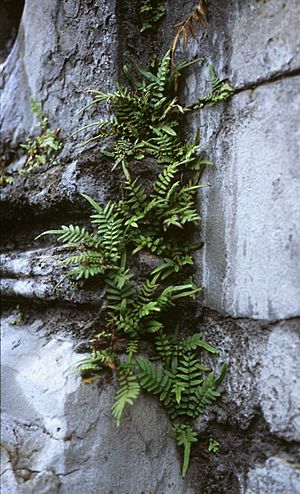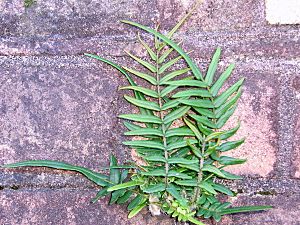Pteris vittata facts for kids
Quick facts for kids Pteris vittata |
|
|---|---|
 |
|
| Scientific classification | |
| Genus: |
Pteris
|
| Species: |
vittata
|
| Synonyms | |
|
|
The Pteris vittata, often called the Chinese brake or ladder brake, is a type of fern. It is part of the Pteridaceae family. This fern is originally from Asia, southern Europe, tropical Africa, and Australia. The first plant sample used to describe this species was found in China.
Contents
Where the Ladder Brake Lives
The Chinese brake fern grows naturally in many parts of the world. It is found across the paleotropics. This includes eastern, southern, and tropical Africa. You can see it in countries like Kenya, South Africa, and Zimbabwe.
It also grows in temperate and tropical Asia. This includes many provinces in China and prefectures in Japan. It is also found in Thailand.
In Australia, it grows in New South Wales, Queensland, Victoria, and Western Australia.
Preferred Growing Spots
Pteris vittata often grows in places with limestone. You might see it on concrete walls or in cracks in buildings. For example, it grows in Sydney, Australia.
This fern is an introduced species in some areas. This means it was brought there by people, not growing there naturally. It now grows in California, Texas, and the Southeastern United States. A small group of these ferns also lives in Sicily, Calabria, and Campania in Italy.
How We Use the Ladder Brake Fern
Even though it grows easily in the wild, people sometimes grow Pteris vittata on purpose. They plant it in gardens because it looks nice.
Cleaning Up the Environment
This fern is also used to help clean up pollution. It is known as a "hyperaccumulator" plant. This means it can take in and store large amounts of harmful substances from the soil.
One special thing about the ladder brake fern is its ability to absorb arsenic. Arsenic is a poisonous chemical. Scientists use this fern in a process called phytoremediation. This is a way to clean up polluted soil using plants. The fern pulls the arsenic out of the ground, helping to make the soil safer.
See also
 In Spanish: Pteris vittata para niños
In Spanish: Pteris vittata para niños


